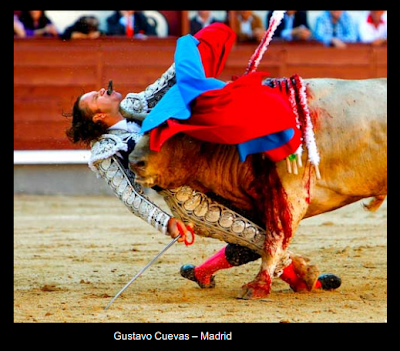After finding a seat in the now packed lecture theatre, it was revealed that in today's lecture we would be coving the topic of picture stories. As much as I was not expecting to learn much from this topic, it was really interesting learning (briefly) about the history of picture stories and how they have progressed over the years. Starting with the indigenous cave painttings found in Australia and France.
Picture stories were very helpful during these periods of times as majority of people were unable to read or write so they communicated through images, much like stained glass in churches and in holy books (as shown below).
Since these times technology progressed and pictures were starting to be used in newspapers, first with illustrated line drawings and then soon followed the use of photographic news stories. Now days we have so much technology available that we can digitally capture and upload pictures and videos instantly to the internet via Facebook or Twitter making there endless possibilities when trying to find information. In fact, technology has advanced so much that the editing, or to be more accurate, distorting or manipulating of pictures has occurred through programs like Photoshop. This can be seen in just about any picture on the cover of a magazine, on movie posters and even on business advertisements (as can be seen in the photo below in which they have pasted another persons face on the middle individual)..
The artificial enhancement of celebrates and idols has forced the appearance to be altered beyond what is natural. This has changed society's thoughts of what ideally a person should look like when it is almost impossible to reach such an appearance without spending a very large sum of money on cosmetic surgery and products. This video is a perfect example of the extent of digital manipulation.
We were asked whether or not Photoshop was good or evil and after thinking about it it can be a combination of the two. Photoshop can be used to the extent where is it just unnatural and unnecessary BUT it can also be used to give an image that slight edge to really bring out what the photographer desired in the image. We next moved to photo journalism and what makes a good photo. I loved the quote that was given to us by Eddie Adams who said "if it makes you laugh, if it makes you cry, if it rips out your heart, that's a good picture." There is so much truth in that statement because what is a good picture (in ones own opinion) if you cannot get some form of emotion from it? A good photo requires the basics of:
- Framing
- Focus
- Angle and Point of View
- Exposure
- Timing
and most importantly, to capture "the moment". My favourite photo example was the bull fighter in Madrid who suffered a heavy blow from the bull he was encountering. Defiantly a photo taken at the perfect moment.
- Framing
- Focus
- Angle and Point of View
- Exposure
- Timing
and most importantly, to capture "the moment". My favourite photo example was the bull fighter in Madrid who suffered a heavy blow from the bull he was encountering. Defiantly a photo taken at the perfect moment.
Drawing to the close of this lecture we were finally shown what is most common today, with the current technology like mobile phones and social networking, to moving pictures. The bases of this is very similar to that of a photograph however instead of capturing the moment we are capturing "the scene" and also included is a sound dimension.
All in all I found this a very interesting lecture, I never would have expected picture stories to have so much depth and history. Very glad I made the decision to attend today's lecture!
All in all I found this a very interesting lecture, I never would have expected picture stories to have so much depth and history. Very glad I made the decision to attend today's lecture!




No comments:
Post a Comment